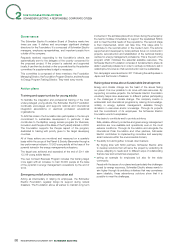APC 2011 Annual Report Download - page 84
Download and view the complete annual report
Please find page 84 of the 2011 APC annual report below. You can navigate through the pages in the report by either clicking on the pages listed below, or by using the keyword search tool below to find specific information within the annual report.
REGISTRATION DOCUMENT 2011 SCHNEIDER ELECTRIC82
SUSTAINABLE DEVELOPMENT
2SCHNEIDER ELECTRIC, A RESPONSIBLE CORPORATE CITIZEN
>WHO IS A PERSON AT THE BASE
OFTHEPYRAMID?
“Base of the pyramid” is a term widely used today
to refer to those with the lowest income either in
the world or in a given country. Whether seen in
absolute terms (income of less than US$1.25 per
day in “purchasing power parity” terms according to
the World Bank) or in relative terms (income of less
than 60% of the average income for the European
Union), poverty affects people in marginalised
situations (infrastructure, isolation, poor access to
banking structures, etc.). Specifi c approaches are
required to meet these challenges and to contribute
to reducing poverty.
Organisation
Management
The program is managed by the Sustainable Development Offi ce.
The BipBop program management team has been strengthened
in 2010 in line with the ambitious objectives set for it in the One
program. The team is now spread equally between France and
India:
•a BipBop solutions Business Development Director;
•an Offer Creation Director based in Bangalore (India);
•a Welfare Investment Director, who manages the Schneider
Electric Energy Access social welfare fund;
•a Training Programs Director;
•BipBop correspondents in key countries (India, Senegal, Nigeria,
South Africa, Brazil, etc.).
Rollout
BipBop operates through its local presence in the countries
concerned by the energy access problem to achieve its goals. With
a few rare exceptions, all projects initiated benefi t from monitoring
by employees of Schneider Electric entities operating in the country.
These employees constitute a network of key contact people for
the design, management and monitoring of projects.
Their involvement may be part or full time. They contribute their
knowledge of the local context (organisation of civil society, local
authorities, the private sector) and guarantee that the project is
aligned with local needs. Their presence is of crucial importance
for the long-term oversight of projects in which Schneider Electric
is involved.
The main areas targeted by BipBop are India, Bangladesh, China,
South Asia, Sub-Saharan Africa and South America.
Three key performance indicators were set in the Planet & Society Barometer for the duration of the One program (2009-2011):
Objectives for Year-End-2011 2011 2010 2009 2008
1. 1,000,000 households at the Base of the Pyramid
have access to energy thanks to Schneider Electric
solutions 1,291,768 891,058 260,000 0
2. 10,000 young adults at the Base of the Pyramid
trained in the energy management professions 12,318 4,742 2,150 0
3. 500 entrepreneurs at the Base of the Pyramid set up
their activities in the energy management fi eld 391 209 125 0
NM =indicator not monitored.
The 2008 performance serves as a starting value for the Planet & Society Barometer One program between 2009 and 2011.
Please refer to pages 90 to 92 for the methodological presentation of indicators, and the following pages for the analysis of the results
(pages 84 for indicator 1, 84-85 for indicator 2 and 88 for indication 3).
Highlights of 2011
•indexation of the performance incentives for the Executive
Committee members to one of more components of the Planet &
Society Barometer, chosen according to their fi eld, for example,
Access to Energy for the Population at the Base of the Pyramid,
for managers in the Asia-Pacifi c and EMEAS zones;
•two out of three BipBop targets were exceeded as a result of
the energy access solutions implemented in the new countries
(Kenya, Burkina Faso and Sierra Leone in particular) and as a
result of the launch of new training programs.
Social welfare investment (Business)
In July2009, Schneider Electric announced the creation of a global
social welfare investment fund called Schneider Electric Energy
Access (SEEA), with an initial capital of EUR3million.
At December31, 2011, the following amounts were managed by
the fund:
•EUR 3,000,000 in capital invested by Schneider Electric;
•EUR 1,000,000 in capital invested by Schneider Energie Sicav
Solidaire;
•EUR 2,000,000 in capital invested by Phitrust Partenaires;
























